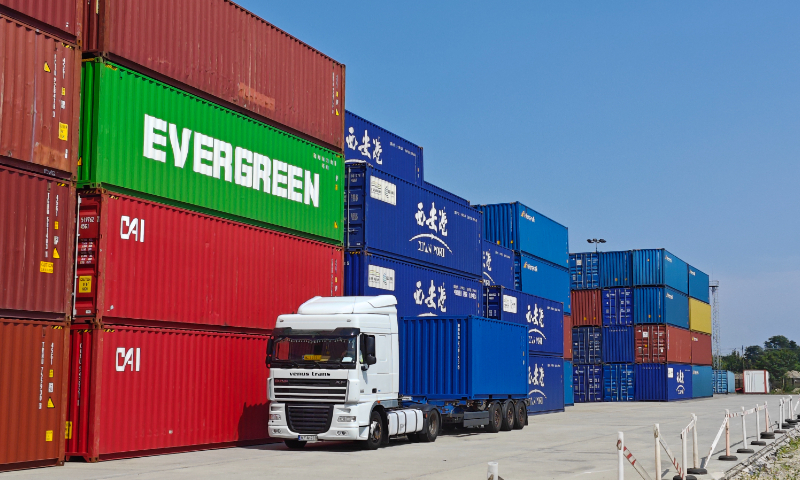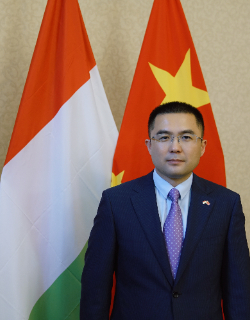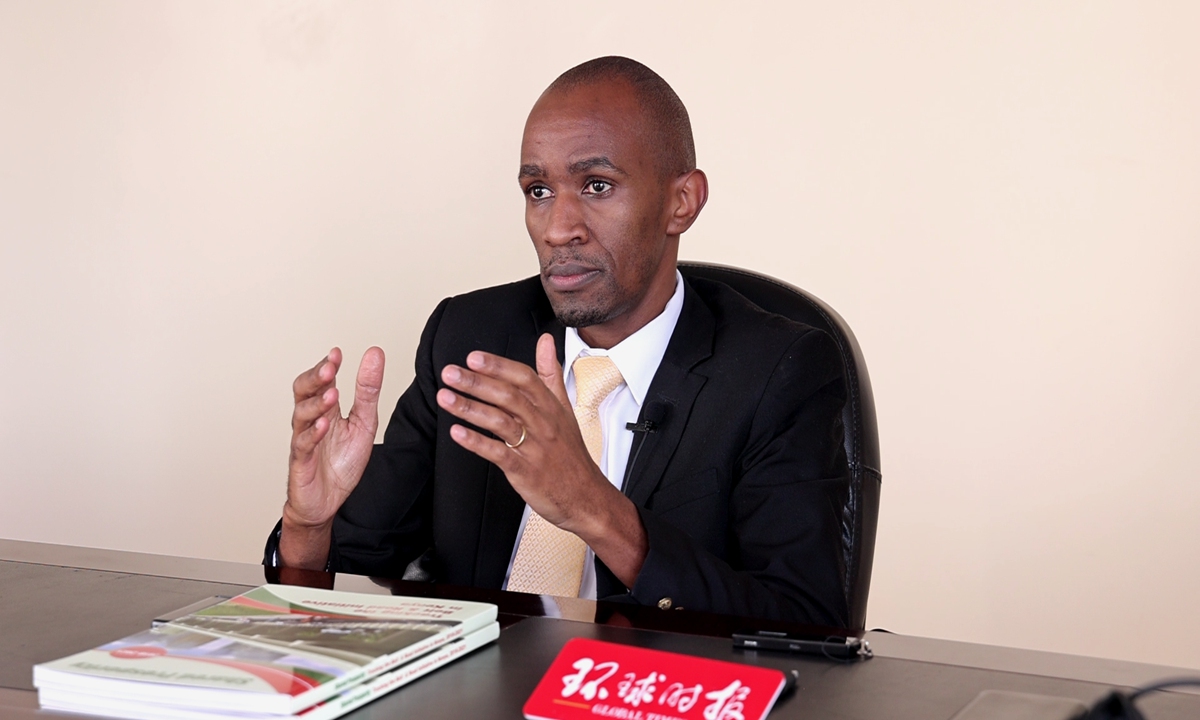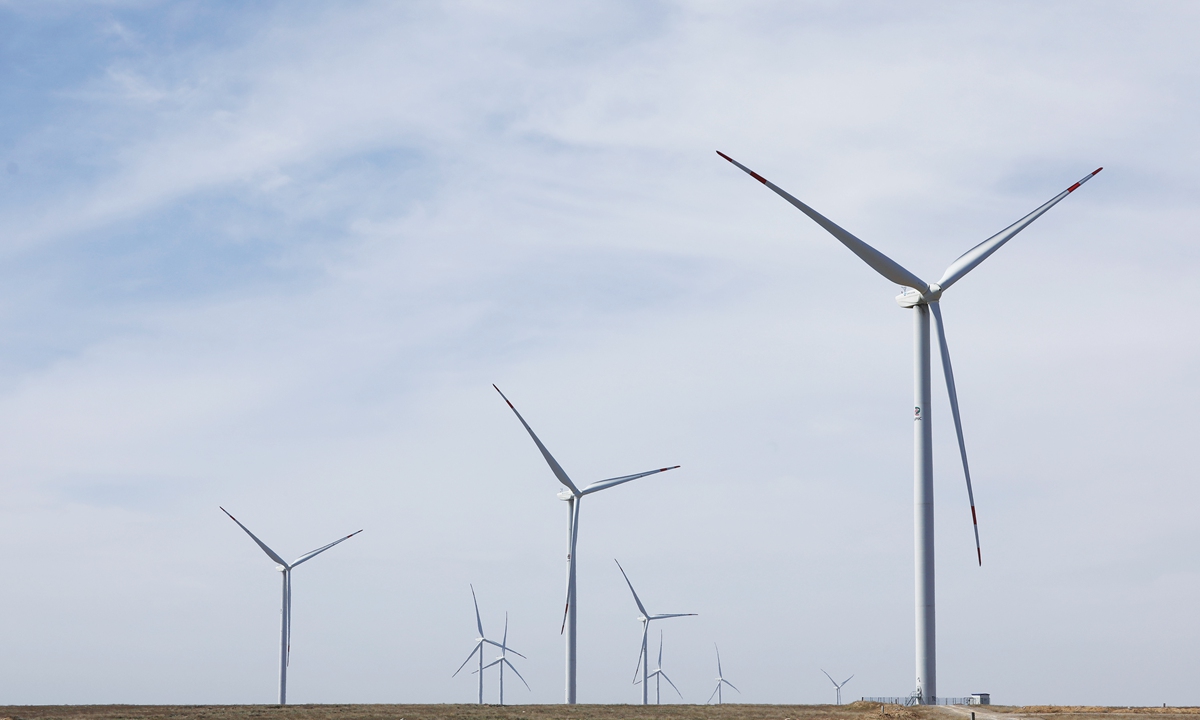Exclusive: China and Hungary forge strong partnership in BRI construction, with more win-win cooperation anticipated: envoy

A snapshot of the Central European Trade and logistics Cooperation Zone in Budapest, Hungary Photo: Yin Yeping/GT
Editor's note:
Hungary has been partnering with China on propelling the construction of the Belt and Road Initiative (BRI) for more than 8 years, injecting momentum into their solid strategic partnership. On the 10th anniversary of the BRI, the Global Times reporter Yin Yeping (GT) interviewed Yang Chao (Yang), the Chinese Embassy's chargé d'affaires in Hungary, discussing how this partnership has thrived amid global geopolitical challenges.

Yang Chao, chargé d'affaires of the Chinese Embassy in Hungary Photo: Courtesy of the Chinese Embassy in Hungary
GT: How do you evaluate the results of bilateral cooperation under BRI framework, and what are the prospects for future cooperation?
Yang: Hungary is the first European country to sign the BRI cooperation document with China. Under the strategic guidance of President Xi Jinping and Prime Minister Viktor Orban, the two sides have adhered to the principle of extensive consultation, joint contribution and shared benefits, and have continuously promoted the in-depth integration of the BRI and Hungary's "opening to the East" policy.
China and Hungary have established a BRI working group to map out specific cooperation projects. In December last year, the two countries signed an agreement to upgrade the working group to the inter-governmental Belt and Road cooperation committee, building a new platform for both parties to jointly build the BRI with high quality. Cooperation between the two countries in the field of infrastructure has been continuously strengthened. Hungary has become an important distribution center for China-Europe freight trains.
Bilateral trade cooperation has overcome the impact of the COVID-19 and grown despite facing external headwinds. Hungary is one of China's most important trading partners in Central and Eastern Europe. Bilateral trade volume reached $15.52 billion in 2022, an increase of 84 percent from 2013.
In terms of financial cooperation, Hungary has become China's largest investment destination in Central and Eastern Europe. Bank of China, China Construction Bank, and China Development Bank have set up branches in Hungary. The Hungarian Central Bank is among the first batch of the central banks of European countries to sign bilateral currency swaps with China.
It can be said that the joint construction of the Belt and Road has injected new momentum into the development of the two-way comprehensive strategic partnership and provided greater space for future development. It has also played a positive role in deepening cooperation between China and Central and Eastern European countries and promoting the healthy and stable development of China-EU relations.
China and Hungary are staunch partners in jointly building BRI. Prime Minister Orban has participated in two consecutive Belt and Road Forum for International Cooperation.
This fall, China will host the third Belt and Road Forum for International Cooperation. The two sides will take the opportunity to plan a new blueprint to deepen their cooperation.
GT: The Hungary-Serbia Railway under construction is the initiative's most important flagship project for Hungary. How is the current progress of this project? How do you evaluate the project's role in promoting regional development?
Yang: The Hungary-Serbia Railway is a landmark BRI project, jointly built by China, Hungary and Serbia. It is the first railway project that China participated in the construction of in Europe, and it is also the first time that China's railway technology and equipment have been connected with the EU's railway interconnection specifications. Construction of the Hungarian section of the route started in July 2020. With the joint efforts of both parties, the progress is currently going smoothly. On May 30 this year, the project entered the comprehensive track laying construction stage. According to the plan, the project will be completed in mid-2025.
After the project's completion, the time from Belgrade to Budapest will be shortened from eight hours to three hours, which will strengthen the north-south interconnection in Central and Eastern Europe, and become a traffic artery connecting Hungary and Serbia. This will greatly facilitate the goods between the two countries and personnel exchanges, and promote economic development in areas along the railway. The Hungary-Serbia Railway will further strengthen Hungary's position as a transportation and logistics hub in Central and Eastern Europe, and play an important role in realizing Hungary's national development goals.
GT: This year marks the beginning of the second decade of China-Central and Eastern European countries cooperation. Where do you think China, Hungary, and the Central and Eastern European countries can engage in deeper collaboration to achieve mutual prosperity?
Yang: Over the past 10 years since the establishment of the China-Central and Eastern European countries cooperation mechanism, both sides have upheld mutual respect and win-win cooperation. Under the guidance of the head-of-state meeting mechanism, both parties have established a cooperative network encompassing various fields, effectively promoting China's relations with countries in the region.
Hungary is one of the initiators of the China-Central and Eastern European countries cooperation mechanism, and Prime Minister Orban personally attended the successive meetings of leaders from China and Central and Eastern European countries. Within the framework of this cooperation mechanism, exchanges and cooperation between China and Hungary in various fields have been comprehensively enhanced, and numerous key projects have taken root in Hungary.
The successful story of Hungary's participation in the cooperation of China-Central and Eastern European countries demonstrates that the cooperative mechanism aligns with the practical needs of both parties, serves the common interests of China, the regional countries, and delivers tangible benefits.
Looking ahead to the next 10 years, all parties should actively implement the important consensus reached at the leadership summit, planning China-Central and Eastern European countries cooperation with greater confidence and higher goals.
Firstly, it's important to adhere to a results-oriented approach, continuously enrich the content of the cooperative mechanism, achieve more tangible outcomes, and enhance the sense of participation among all parties involved.
Secondly, it's crucial to maintain an innovation-driven approach, continuously exploring new areas and formats of cooperation on the foundation of existing successful collaboration. This involves creating new growth opportunities for cooperation in fields such as clean energy, digital economy, new energy vehicles, cross-border e-commerce, and vocational education.
GT: What are your comments on the growing cooperation between the business circles of the two countries in new energy? What are your expectations for future bilateral cooperation in this field?
Yang: Against the backdrop of rapid technological advancement and industrial transformation, vigorously developing new energy sources can not only effectively substitute fossil fuels, reduce external energy dependency, and promote energy self-sufficiency but also cultivate strategic emerging industries and accelerate technological progress.
The Hungarian government began planning the expansion of new energy applications quite early and even introduced long-term energy strategic documents to strongly encourage and support new energy development. China possesses advantages in the global new energy industry, such as technological advancement, a vast market, and a high level of industrial chain maturity. The cooperation between China and Hungary in the field of green energy is complementary and holds immense potential.
Currently, both countries are experiencing rapid cooperative development in this field and have achieved significant results. The largest solar power plant in Central and Eastern Europe, the 100-megawatt photovoltaic power station in Hungary's Kaposvar, developed by China National Machinery Import and Export Corporation, has been connected to the grid, aiding Hungary in increasing its photovoltaic capacity by 5 percent and reducing carbon dioxide emissions by 120,000 tons annually.
The first electric vehicle factory established in Europe by China's top electric vehicle brand, BYD, is operating smoothly in Hungary, becoming one of the leaders in the European electric passenger bus market. Multiple Chinese lithium battery and component manufacturers have invested in factories in Hungary, promoting the transformation of the Hungarian automotive industry toward electrification. Cooperation between the two sides in the field of new energy will bring about more opportunities and practical collaborative projects.
GT: How do you assess the impact of the China-Europe freight train on promoting Hungary's economic development? What are the potential areas for expansion in cooperation between them?
Yang: The China-Europe freight train serves as a crucial foundation for the collaborative effort between China and Hungary under BRI. It stands as a vital logistics corridor connecting China and Hungary, as well as China and Europe, providing robust support for bilateral trade, investment, and connectivity. Since 2019, the average annual growth rate of bilateral trade between China and Hungary has reached 15 percent, far surpassing that of other EU countries.
Up to now, trains departing from Chinese cities such as Changsha, Xi'an, Chengdu and Chongqing, can transport goods via Hungary to the broad European market. The project further highlights Hungary's role as a key hub within the China-Europe freight train and the European inland rail network. It helps facilitate the entry of high-quality goods from both China and Europe into each other's markets.
In the next steps, building upon the achievements of the China-Europe freight train operations, both sides will leverage the "dual zone linkage" mechanism along with the China-Hungary "Air Silk Road" to promote resource integration and complementary functional advantages.
GT: How do you view the positive impact of the currency settlement cooperation between China and Hungary on reducing the exchange rate risk and transaction costs of using the US dollar for transactions, as well as improving trade efficiency and convenience?
Yang: Currently, there is a significant adjustment happening in the global financial landscape, with the international monetary system moving toward multipolarity. An increasing number of countries are choosing the Chinese yuan as the currency for international trade settlement. China has signed bilateral currency swap agreements with over 40 countries and regions.
The People's Bank of China has authorized 31 Chinese yuan clearing banks in 29 countries and regions. In March, the usage of yuan in cross-border transactions in China surpassed the US dollar for the first time. China-Hungary financial cooperation is at the forefront, leading to notable achievements.
Both sides have repeatedly renewed currency swap agreements, with Bank of China Hungary Branch becoming the first yuan clearing bank in the Central and Eastern European region. Hungary also became the first sovereign country to issue green bonds denominated in yuan.
Since the launch of the "Budapest Renminbi Initiative" in 2015, Hungary's foreign exchange reserve assets denominated in yuan have consistently increased.
The practical achievements of financial connectivity have further reduced the trade costs for both sides, enriched investment and financing options, and also opened up new opportunities for deepening cooperation between the two countries. It is hoped that financial institutions of both countries will continue to work together to create more high-quality financial products, establish more high-level cooperation platforms, and build more efficient communication channels.
GT: Some Western politicians have constantly incited "de-coupling" or "de-risking" measures against China. In response to this, Hungarian Foreign Minister Péter Szijjártó recently said that "any action of 'de-coupling' or 'de-risking' from China would be 'suicidal' for Europe." What is your response to this?
Yang: Hungarian Prime Minister Orban and Foreign Minister Szijjártó, along with other high-ranking officials of the Hungarian government, have actively called for strengthening cooperation between China and Europe. They have repeatedly emphasized that the concept of "de-coupling" between Europe and China is neither realistic nor feasible. Not only would the "de-coupling" not be beneficial for Europe, but it would also disrupt their own development.
We highly appreciate this stance and hope that more European politicians can have an objective and rational understanding of cooperation between China and Europe.
The development of economic globalization up to today has led to mutual integration, interdependence, mutual achievements, and shared development among countries. This is inherently a positive phenomenon, rather than a negative one.
China and the EU should uphold openness and inclusiveness, jointly promote the process of globalization, safeguard the free trade system, jointly oppose protectionism, and resist unilateral bullying.
Common development is the best means to resist risks. China adheres to the path of peaceful development and firmly pursues an opening-up strategy of mutual benefit and win-win results.
What China brings to the world is opportunity rather than challenge, stability rather than turmoil, and security rather than risk. In fact, many European companies have taken practical actions to say no to "de-risk" and continue to expand investment and cooperation in China.
GT: What achievements have been made in the people-to-people cultural exchanges between China and Hungary in the past 10 years?
Yang: There is a profound friendship between China and Hungary and the two peoples, which is a valuable asset of bilateral relations and the basis for long-term friendship between the two countries. Under the BR framework, there are many highlights in cooperation between the two countries in education, culture, science and technology, sports, youth and other fields, which has effectively promoted mutual understanding between the two peoples.
The Hungarian-Chinese Bilingual School in Budapest is the only full-time public school in Central and Eastern Europe that uses local language and Chinese teaching at the same time. On the eve of this year's Spring Festival, President Xi personally replied to the students of the school, encouraging Hungarian young people to learn more about China and to be envoys to develop China-Hungary friendship, which aroused strong repercussions.
Chinese has become one of the most popular languages among young people in Hungary. It has also been included in the Hungarian national education system and has become one of the subjects of the college entrance examination.
It can be said that the Hungarian-Chinese Bilingual School is a witness of the profound friendship between the two countries and an epitome of the increasingly close cultural exchanges between China and Hungary. There are also five Confucius Institutes in Hungary, among which the Confucius Institute at Eötvös Loránd University is the first "Model Confucius Institutes" in the world.
The Chinese Department of Eötvös Loránd University has trained many well-known sinologists, and this year will celebrate the 100th anniversary of the establishment of the department. Many Hungarian translators and publishers, including the famous Hungarian sinologist Józsa Sándor, won the Special Book Award of China.
China and Hungary have also established cultural centers in each other's countries. This year, both sides have organized a series of activities to celebrate the 200th anniversary of the birth of the famous Hungarian poet Sándor Petőfi, which has greatly promoted cultural exchanges between the two countries.
Several Hungarian experts have been awarded the Chinese Government Friendship Award, becoming the shining example of China-Hungarian technological cooperation. The two countries have also strengthened exchanges in sports and among young people. At the recently concluded 31st FISU Summer World University Games held in Chengdu, Sichuan Province, Hungary sent a team of nearly 100 participants and achieved outstanding results by winning 17 medals.
The friendship between China and Hungary continues to deepen at all levels, taking root in grassroots communities and benefiting the people. The two countries have established friendly relationships between 44 pairs of provinces, states, and cities, creating a robust network for bilateral exchanges and cooperation.
Amity between the people holds the key to sound state-to-state relations. The multifaceted and comprehensive cultural exchanges between our two nations will undoubtedly foster greater mutual understanding and closeness among the two peoples. This will further fortify the foundation of friendship between our two countries and propel the continuous advancement of the comprehensive strategic partnership between China and Hungary.



